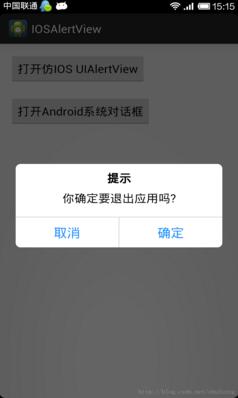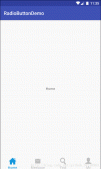本文实例为大家分享了Android仿IOS UIAlertView对话框的具体代码,供大家参考,具体内容如下
显示效果:

我在参考链接中看到了作者的仿的qq提示框,但是在使用的时候并不是很方面,有一些不足,于是我参照Android系统AlertDialog,使用参考链接中的布局文件和style文件,用自己的方法自定义了一下这个仿IOS上面UIAlertView的效果,这样的话让我们可以想使用系统AlertDialog一样使用我自定义的CustomDialog。
CustomDialog使用代码:
|
1
2
3
4
5
6
7
8
9
10
11
12
13
14
15
16
17
18
19
20
21
22
23
24
25
26
27
28
29
30
31
32
33
34
35
36
37
38
39
40
41
42
43
44
45
46
47
48
49
50
51
52
53
|
package com.example.iosalertview; import android.app.Activity; import android.app.AlertDialog; import android.os.Bundle; import android.view.View; import android.view.View.OnClickListener; import android.widget.Button; import com.example.iosalertview.CustomDialog.Builder; public class MainActivity extends Activity implements OnClickListener{ private Button ios_dialog_btn,android_dialog_btn; @Override protected void onCreate(Bundle savedInstanceState) { super.onCreate(savedInstanceState); setContentView(R.layout.activity_main); ios_dialog_btn = (Button) findViewById(R.id.ios_dialog_btn); android_dialog_btn = (Button) findViewById(R.id.android_dialog_btn); ios_dialog_btn.setOnClickListener(this); android_dialog_btn.setOnClickListener(this); } @Override public void onClick(View v) { switch (v.getId()) { case R.id.ios_dialog_btn: CustomDialog.Builder builder = new Builder(MainActivity.this); builder.setTitle(R.string.prompt); builder.setMessage(R.string.exit_app); builder.setPositiveButton(R.string.confirm, null); builder.setNegativeButton(R.string.cancel, null); builder.create().show(); break; case R.id.android_dialog_btn: AlertDialog.Builder mbuilder = new AlertDialog.Builder(MainActivity.this); mbuilder.setTitle(R.string.prompt); mbuilder.setMessage(R.string.exit_app); mbuilder.setPositiveButton(R.string.confirm, null); mbuilder.setNegativeButton(R.string.cancel, null); mbuilder.create().show(); break; default: break; } } } |
自定义CustomDialog代码:
|
1
2
3
4
5
6
7
8
9
10
11
12
13
14
15
16
17
18
19
20
21
22
23
24
25
26
27
28
29
30
31
32
33
34
35
36
37
38
39
40
41
42
43
44
45
46
47
48
49
50
51
52
53
54
55
56
57
58
59
60
61
62
63
64
65
66
67
68
69
70
71
72
73
74
75
76
77
78
79
80
81
82
83
84
85
86
87
88
89
90
91
92
93
94
95
96
97
98
99
100
101
102
103
104
105
106
107
108
109
110
111
112
113
114
115
116
117
118
119
120
121
122
123
124
125
126
127
128
129
130
131
132
133
134
135
136
137
138
139
140
141
142
143
144
145
146
147
148
149
150
151
152
153
154
155
156
157
158
159
160
161
162
163
164
165
166
167
168
169
170
171
172
173
174
175
176
177
178
179
180
181
182
183
184
185
186
187
188
189
190
191
192
193
194
195
196
197
198
199
200
201
202
203
204
205
206
|
package com.example.iosalertview; import android.app.Dialog; import android.content.Context; import android.content.DialogInterface; import android.view.LayoutInflater; import android.view.View; import android.view.ViewGroup.LayoutParams; import android.widget.Button; import android.widget.LinearLayout; import android.widget.TextView; public class CustomDialog extends Dialog { public CustomDialog(Context context) { super(context); } public CustomDialog(Context context, int theme) { super(context, theme); } public static class Builder { private Context context; //上下文对象 private String title; //对话框标题 private String message; //对话框内容 private String confirm_btnText; //按钮名称“确定” private String cancel_btnText; //按钮名称“取消” private View contentView; //对话框中间加载的其他布局界面 /*按钮坚挺事件*/ private DialogInterface.OnClickListener confirm_btnClickListener; private DialogInterface.OnClickListener cancel_btnClickListener; public Builder(Context context) { this.context = context; } /*设置对话框信息*/ public Builder setMessage(String message) { this.message = message; return this; } /** * Set the Dialog message from resource * * @param title * @return */ public Builder setMessage(int message) { this.message = (String) context.getText(message); return this; } /** * Set the Dialog title from resource * * @param title * @return */ public Builder setTitle(int title) { this.title = (String) context.getText(title); return this; } /** * Set the Dialog title from String * * @param title * @return */ public Builder setTitle(String title) { this.title = title; return this; } /** * 设置对话框界面 * @param v View * @return */ public Builder setContentView(View v) { this.contentView = v; return this; } /** * Set the positive button resource and it's listener * * @param confirm_btnText * @return */ public Builder setPositiveButton(int confirm_btnText, DialogInterface.OnClickListener listener) { this.confirm_btnText = (String) context .getText(confirm_btnText); this.confirm_btnClickListener = listener; return this; } /** * Set the positive button and it's listener * * @param confirm_btnText * @return */ public Builder setPositiveButton(String confirm_btnText, DialogInterface.OnClickListener listener) { this.confirm_btnText = confirm_btnText; this.confirm_btnClickListener = listener; return this; } /** * Set the negative button resource and it's listener * * @param confirm_btnText * @return */ public Builder setNegativeButton(int cancel_btnText, DialogInterface.OnClickListener listener) { this.cancel_btnText = (String) context .getText(cancel_btnText); this.cancel_btnClickListener = listener; return this; } /** * Set the negative button and it's listener * * @param confirm_btnText * @return */ public Builder setNegativeButton(String cancel_btnText, DialogInterface.OnClickListener listener) { this.cancel_btnText = cancel_btnText; this.cancel_btnClickListener = listener; return this; } public CustomDialog create() { LayoutInflater inflater = (LayoutInflater) context .getSystemService(Context.LAYOUT_INFLATER_SERVICE); // instantiate the dialog with the custom Theme final CustomDialog dialog = new CustomDialog(context, R.style.mystyle); View layout = inflater.inflate(R.layout.customdialog, null); dialog.addContentView(layout, new LayoutParams( LayoutParams.MATCH_PARENT, LayoutParams.WRAP_CONTENT)); // set the dialog title ((TextView) layout.findViewById(R.id.title)).setText(title); ((TextView) layout.findViewById(R.id.title)).getPaint().setFakeBoldText(true);; // set the confirm button if (confirm_btnText != null) { ((Button) layout.findViewById(R.id.confirm_btn)) .setText(confirm_btnText); if (confirm_btnClickListener != null) { ((Button) layout.findViewById(R.id.confirm_btn)) .setOnClickListener(new View.OnClickListener() { public void onClick(View v) { confirm_btnClickListener.onClick(dialog, DialogInterface.BUTTON_POSITIVE); } }); } } else { // if no confirm button just set the visibility to GONE layout.findViewById(R.id.confirm_btn).setVisibility( View.GONE); } // set the cancel button if (cancel_btnText != null) { ((Button) layout.findViewById(R.id.cancel_btn)) .setText(cancel_btnText); if (cancel_btnClickListener != null) { ((Button) layout.findViewById(R.id.cancel_btn)) .setOnClickListener(new View.OnClickListener() { public void onClick(View v) { cancel_btnClickListener.onClick(dialog, DialogInterface.BUTTON_NEGATIVE); } }); } } else { // if no confirm button just set the visibility to GONE layout.findViewById(R.id.cancel_btn).setVisibility( View.GONE); } // set the content message if (message != null) { ((TextView) layout.findViewById(R.id.message)).setText(message); } else if (contentView != null) { // if no message set // add the contentView to the dialog body ((LinearLayout) layout.findViewById(R.id.message)) .removeAllViews(); ((LinearLayout) layout.findViewById(R.id.message)).addView( contentView, new LayoutParams( LayoutParams.WRAP_CONTENT, LayoutParams.WRAP_CONTENT)); } dialog.setContentView(layout); return dialog; } } } |
demo下载地址:Android仿IOS UIAlertView对话框
以上就是本文的全部内容,希望对大家的学习有所帮助,也希望大家多多支持服务器之家。
原文链接:https://blog.csdn.net/zhufuing/article/details/18735371














